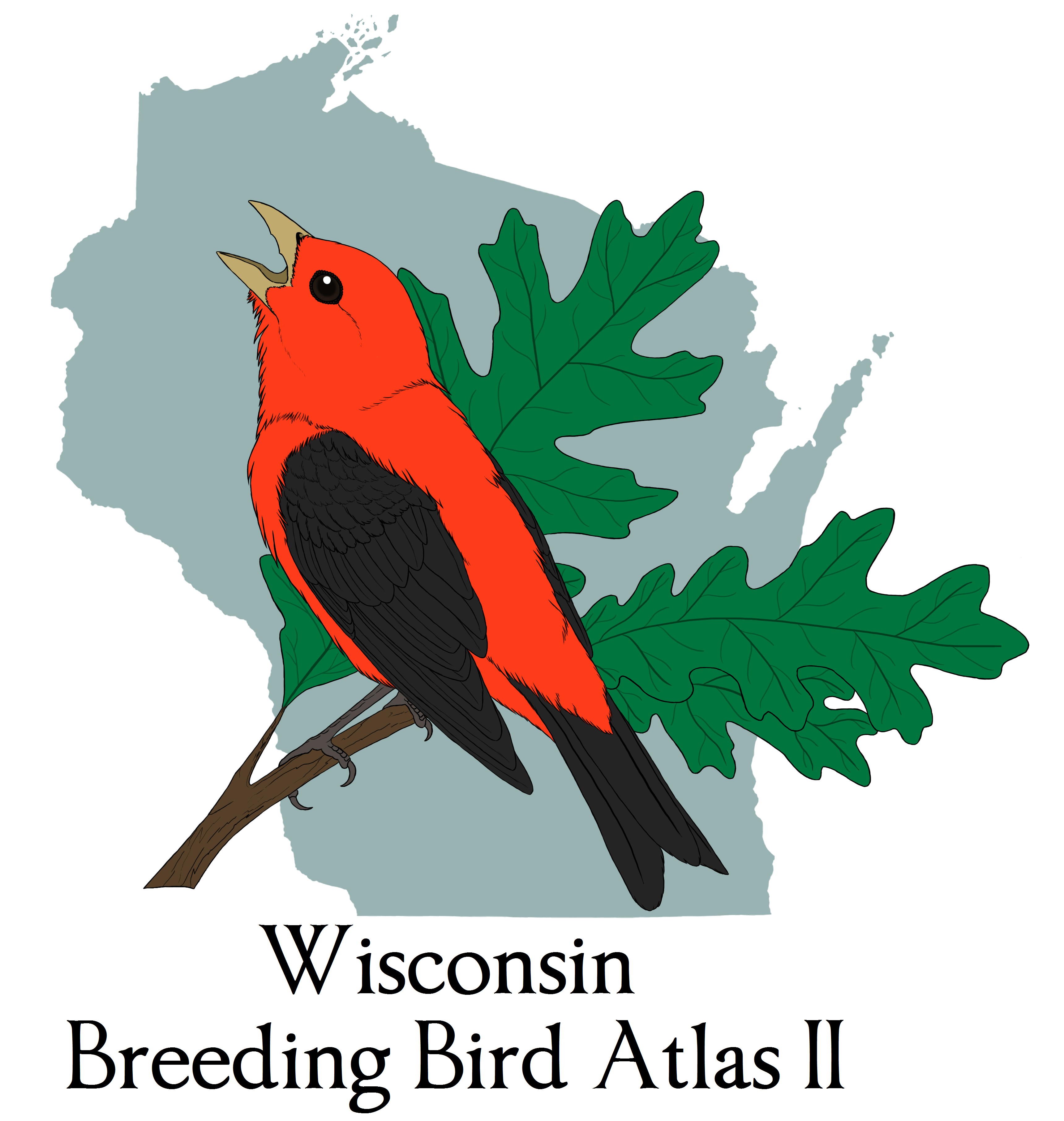-By Nick Anich and Carrie Becker-

2019 is slated to be the final year of field work for the 2nd Wisconsin Breeding Bird Atlas, and the Atlas team needs all hands on deck this year to complete this monumental effort by mid-August. Here are the best ways to jump in:
++ Check the map of blocks left to be complete at http://wiatri.net/projects/WBBA/WBBAmap.cfm - Click the box to toggle ON assigned blocks to see the blocks near you that are still in progress.
++ Email a County Coordinator at https://wsobirds.org/atlas-county-coordinators to find out where you can help.
++ Check the Atlas eBird Effort Map at  https://ebird.org/atlaswi/effortmap and eBird Explore Atlas Regions at
https://ebird.org/atlaswi/effortmap and eBird Explore Atlas Regions at  https://ebird.org/atlaswi/explore to follow the real-time block completion progress.
https://ebird.org/atlaswi/explore to follow the real-time block completion progress.
++Get a handle on what tasks need to be completed each month in order to finish blocks by mid-August at  https://ebird.org/atlaswi/news/suggested-visit-schedule-for-finishing-a-block-in-a-single-year and head out into the field.
https://ebird.org/atlaswi/news/suggested-visit-schedule-for-finishing-a-block-in-a-single-year and head out into the field.
Top 10 tips for getting confirmations
An atlas block is complete when: at least 80% of the species found there during the first Atlas have been detected; at least 50% of those detected species have been confirmed breeding; 20+ survey hours have been conducted during different times of year; all habitat types have been covered; and two night visits have occurred.
Though every remaining open block has individual needs, confirming breeding activity is going to be a huge part of what’s needed in most blocks yet this summer. These tips will help you maximize your time to earn more confirmations.
1. Try for easy species – Look for those conspicuous birds around town: American Robin, European Starling, Common Grackle, Chipping Sparrow; species that are easy to see in open habitats: Red-winged Blackbird, Killdeer, swallows; and populous waterfowl with easy-to-spot broods: Canada Goose, Mallard, Wood Duck.
2. Get up early – The dawn chorus and subsequent burst of activity is generally the time of the day with the most action, and getting up and out for the sunrise is worth it. Midday usually produces a lull, but on cloudy days birds can be active a bit longer. There is a second activity period where things can pick back up from dusk to evening. The beginning and end of the day can also pretty easily be combined with an hour of nocturnal atlasing.
3. Find productive habitats – All habitats are worth working, but in many cases young birds are specifically brought into denser habitats so spots with shrubs and forests with a dense understory can be especially productive. Or areas with a food source like feeders or berry bushes.
4. Station yourself in a spot with good visibility – Locations where you can see a fair distance (especially in wooded landscapes, clearings or rivers) can be valuable, as can locations where you expect birds to be perched and visible (power lines, fence lines and dead snags).
5. Follow an individual bird. You’ve got your list of species you need, so if you encounter one, follow it for 5 or 10 minutes to see if it’s up to something. If you become suspicious of breeding activity, watch it for even longer. It’s a satisfying feeling to stalk your quarry and then see it with food or feeding young!
6. Stand still – As you’re sitting there watching your bird, you may notice other birds sneaking around. If you can be quiet and unobtrusive, you have a better chance of spotting reclusive birds feeding young. Remember, the pace of atlasing is generally much slower than regular birding.
7. Carefully watch behaviors – Not all fledglings are obvious, but watching behaviors can help you interpret what is going on. Are there four birds in the same tree? Any more than two birds should get you suspicious about young. Scrutinize young birds for a pale fleshy gape (pale corners of mouth). Is that bird frozen in place? It may be a fledgling trying not to be seen or a female waiting until you back away to return to her nest. Are birds coming and going from the same direction? There may be a nest or young in that bush. Any bird not acting “normal” may not want to reveal its nest or young with you around. If the bird is not doing anything further, try backing away a bit and continuing to observe it from a distance.
8. Be alert for any chipping noises – You don’t have to know right away what kind of bird is making chipping noises, but at this time of year you should investigate any and all chipping noises as they are often fledglings begging for food, parents calling to young, or parents agitated about your presence. This is usually much more productive than staking out or chasing males that are repeatedly singing, since intense singers this time of year are often unpaired or barely involved in raising the young.
9. If you find a puzzling fledgling, wait for the parents to show up – Birds that are too young to be readily identifiable are generally still being fed by parents on a regular basis, so station yourself in a location that is a bit hidden but with a good view of the fledgling, and wait to see who shows up with food (or, if you are too close, who chips at you angrily!)
10. Finding nests is not necessary – In fact, codes like ON (Occupied Nest), NY (Nest with Young), and NE (Nest with Eggs) are uncommon for most songbird species. It’s nice when you chance onto a nest but not worth your time to beat the bushes looking for one. It’s much easier to catch an adult carrying food (CF) or feeding young (FY), or to find a fledgling (FL)!
--This is one of several timely articles in this month's Badger Birder newsletter; don't miss out on the latest birding and conservation news. Become a WSO member today! https://wsobirds.org/support/become-a-member--

